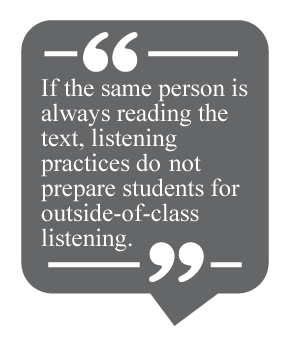2 More Easy Strategies for Teaching Listening
by Olga Uzun
 This article is the second part of “Easy Strategies for Teaching Listening,” published in the November 2018 issue of TESOL Connections. In the first article, we learned about demonstrating the difference between hearing and listening (Strategy 1), and about teaching a variety of speech markers (Strategy 2).
This article is the second part of “Easy Strategies for Teaching Listening,” published in the November 2018 issue of TESOL Connections. In the first article, we learned about demonstrating the difference between hearing and listening (Strategy 1), and about teaching a variety of speech markers (Strategy 2).
It is common for students to recognize words printed on paper but not be able to comprehend them in listening material. Ideally, all new words should be taught with a clear demonstration of their pronunciation. This is easy to achieve by asking students to repeat after you or requesting they use online dictionaries, such as Merriam-Webster or the Longman Dictionary of Contemporary English Online, where students can hear how a word sounds. For the words that have already been taught, different listening activities could be created to practice listening comprehension.
Strategy 3: Practice Listening to Different Speakers
Students get used to the voice (and pronunciation and, if present, an accent or dialect) of their teacher. Even listening comprehension textbooks with audio material often have recordings of the same speakers, repeatedly. If the same person is always reading the text, listening practices do not prepare students for outside-of-class listening. Following are a few activities to address and remedy this issue.
Activity 1. Multivoice Listening
The goal of this activity is to practice listening to a real flowing speech and easy recognize taught vocabulary in an aural setting.
Steps
-
Read a text.
-
Play a recording of the same text read by another person. This can easily be done with just a cell phone. If you are in an English-dominant country, enlist colleagues, family, or friends. If English speakers are not readily available, ask for volunteers on an ESL-type forum. You might be surprised how many people will be happy to volunteer to become your voice actors.
-
If possible, play the same text recorded by more people.
Activity 2. Accent Guess
I love using The Speech Accent Archive, which has a plethora of audio recordings of the same text read by people from all over the world. Students could guess the country (or a U.S. state) of a speaker or practice listening to different people reading the same text.
 Activity 3. Accent Tag
Activity 3. Accent Tag
Accent Tag, a viral YouTube challenge, originated when Prof. Bert Vaux posted an online dialect survey in 2003. The survey requires participants to record themselves answering a series of questions (to determine dialect) and then pronouncing a list of words (to determine pronunciation).
In Accent Tag, people answer the same set of questions but often add details. After students record their videos, let them view some of the other submissions to learn about different dialects and English pronunciation. This challenge can be used with higher level classes. Keep in mind that not all videos are class friendly and should be previewed by an instructor.
Activity 4. Automated Phone Practice
Students often find it challenging to understand automated phone systems, especially when they have to press various numbers on the phone to get connected to the right person. If you work with beginners or low intermediate students, draw a rectangular touch phone number box on the board and assign students their own messages. For example, one student will play a customer and will “dial” the number (good practice for listening to numbers) and another will read the main message:
You have reached the office of Doctor Smith. To better help you with the call, please listen to the following menu. If you would like our office’s address, please press 1. If you would like to know the hours of operation, press 2. If you would like to leave a message for a nurse, press 3. If you have a billing question, press 4. If you would like to schedule an appointment, please press 5. If you would like to repeat the menu, please press 6.
A “customer” will press the needed number and Students 1–5 (for each number on the “recording”) will “play” (speak) the message, for example, an address, you have provided in advance.
The possibilities for this game are endless. The text can be easily modified, depending on the topic of the class. After building some confidence, students could practice calling the real services they were intimidated to call before.
Strategy 4: Encourage Daily Listening Practice
Listening is a physical skill that can’t be improved with one or two practices a week. I like to use a running analogy: to be good at it and improve my speed and endurance, I have to practice running almost every day. If I do it once a week, even for an hour, I’ll never be able to finish a marathon. Here are some activities students can do daily on their own to improve their listening.

Academic Listening Practice
Students need to be motivated to practice listening outside the classroom. They need to want to practice to become successful but will also need to know how to do it and what to expect. If your classes are academic, encourage your students to listen to authentic high school or university lectures. There are thousands of free lectures online. Many universities have official YouTube channels. For example, the following universities offer free lectures, and in some cases full courses:
Khan Academy has videos of school materials at all levels that can be accessed free of charge. If your ESL students are struggling with both English and another school subject, listening to a course online could help them with both that subject and listening comprehension in English.
Ask your students not to use video subtitles; in real life, speakers won’t have running text above them. Even though students might be intimidated listening to a real lecture, encourage them to continue. Like with running, it will become easier. Of course, choose the level of listening appropriately. Do not assign a graduate level university lecture to high school students, because they will lack knowledge of the material even in their own language.
If the whole class listens to the same lecture outside of class, encourage students in class to ask each other to fill in what they have missed. After that, tell students to pretend that they are professors of that class and create three questions they could ask their classmates about the lecture material. The students then could sit together in a circle and ask/answer the questions.
Keep a Listening Journal
Advise your students to keep a journal, take notes, and write a short reflection on their level of comprehension of the material. Listening journals could be controlled or free-flowing. In controlled journals, you choose the videos, and in free-flowing, students are in control of their listening materials.
Read Short Stories
Short stories are also great for daily listening practice. Students could read a story first and then listen to it or vice versa. As with lectures, it is easy to find audio recordings online. Here are some examples:
Mix and match different strategies to keep students’ interest. Note that listening activities need to meet three criteria for students to be motivated to practice daily listening:
- The topic must be interesting to students.
- The level of difficulty must be appropriate.
- There must be teacher feedback.
Conclusion
Teaching listening is extremely important because people listen (actively and passively) more than they speak, read, and write. Unfortunately, there are not as many resources for teaching listening as for grammar, writing, and reading. The strategies here and in Part 1 of this series will, hopefully, not only help you in the classroom but will also inspire new ideas. I would love to hear how you teach listening. The more we collaborate, the more developed the science of teaching listening will be.
Olga Uzun is a North Carolina State University Intensive English Program lead instructor for listening and note-taking. Not an English native speaker she, like many of her students, struggled with ESL listening comprehension in the past. A regular presenter at professional conferences, Olga is interested not only in listening but also in ways to improve the ways we teach grammar and reading comprehension.